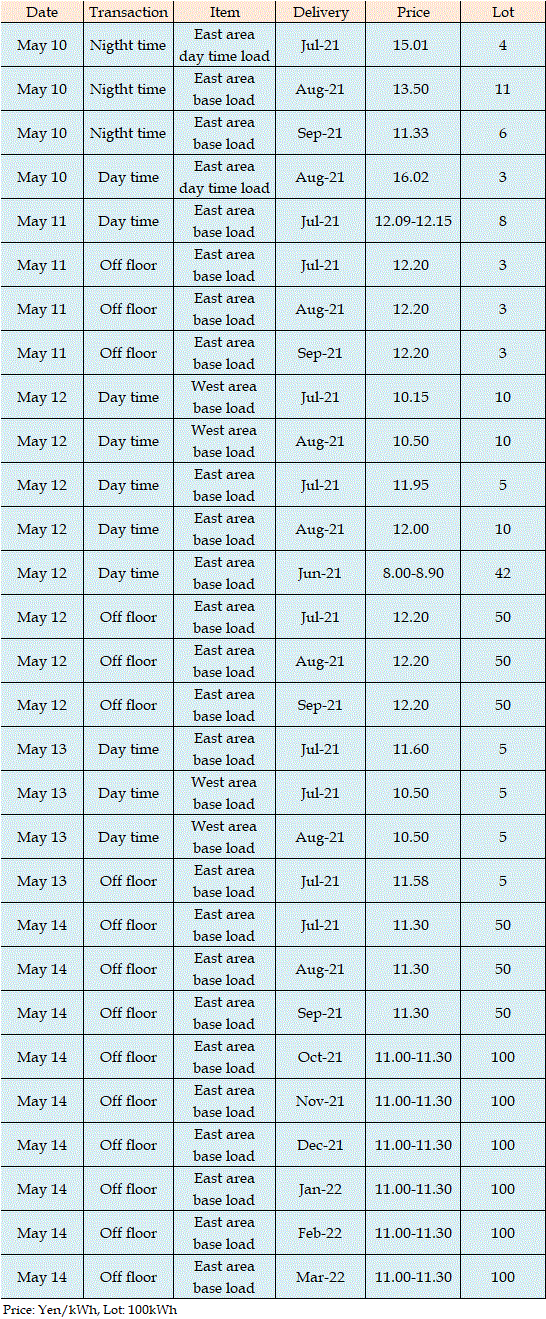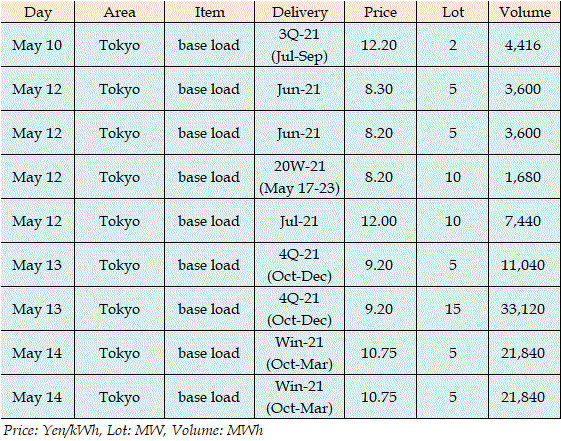Power: May 10-14: Weekly average marks Yen 7 level on tighter solar supply
|
In the day-ahead market on JEPX (Japan Electric Power Exchange), the 24-hour spot power prices for May 10-14 delivery were in the Yen 7 level in both East Japan and West Japan. Power demand returned to normal after the long holidays while the weather was cloudy for most of the week. Southern Kyushu entered the rainy season on May 11, a point that was 19 days earlier than the average year and last year. Reflecting such weather conditions, Kyushu escaped from Yen 0.01 on May 12 onward. Including Kyushu, spot prices were generally solid across Japan.
The actual highest price during the week was at Yen 13.00 in eight areas from Hokkaido to Shikoku for May 11 delivery. The actual lowest price during the week was at Yen 0.01 in the system price for May 10 delivery and Kyushu for May 10-11 delivery.
By area, the weekly average of the 24-hour spot prices was at Yen 7.37 in Hokkaido and Tohoku, Yen 7.52 in Tokyo, Yen 7.51 in five areas including Chubu, Hokuriku, Kansai, Chugoku and Shikoku, and Yen 7.05 in Kyushu.
Power demand in nine areas of Japan during May 10-14 was a combined 10,732.42 mil kWh, up 18.1% from 9,084.68 mil kWh during May 3-7. The figure was up 6.1% from the corresponding period a year earlier. Demand during May 11-15, 2020 after day of week adjustment was 10,110.68 mil kWh.
In the JEPX forward market, no deals were reported during May 10-14.
Deals reported on TOCOM (Tokyo Commodity Exchange) during May 10-14 were as below.
Deals reported on EEX (European Energy Exchange) during May 10-14 were as below.
During the week starting May 17, the weather is forecast to remain cloudy across Japan. A wider range of areas are expected to enter the rainy season, and a possible tightness in solar power supply will likely push up day time prices. The highest temperature is likely to stay around 25 degrees from Kyushu to southern Tohoku, a factor that could give a boost to air-conditioning demand.
Meanwhile, the Japanese government extended the deadline of the COVID-19 state of emergency in Tokyo, Kyoto, Osaka and Hyogo to May 31. The measures were taken since Apr 25 and originally effective through May 11. The state of emergency was also declared in Aichi and Fukuoka on May 12, with a deadline on May 31. In rural areas as well, the quasi-emergency measures are taken in more and more prefectures. The move could hammer down power demand across Japan. |





